|
 |
| Annette with her sons Luis (left) and
Charles |
Mexico
City, Jan 1, 2002
Dear Mr.
Hocker:
It was a
pleasure to hear from you. I apologize for not getting back to you sooner,
but I have been working
on this reply since you emailed me. I will try to answer your questions in
the order in which you give them, more or less.
I first remember meeting Conlon when we were
living in our house on Calzada de las Aguilas #50, probably around
1943/44. My father was away at war (he was stationed on an aircraft
carrier, the USS Bon Homme Richard, in the Pacific Ocean.) My mother,
Annette, my brother Charles and myself were living in the above-mentioned
house. (Aguilas #50 was built by my father and mother with Arquitecto
Manuel Parra on a large piece of land, about 7,500m2. On this
same property, in 1948, my mother built another home, Aguilas #48. This is
the house in which I now live.
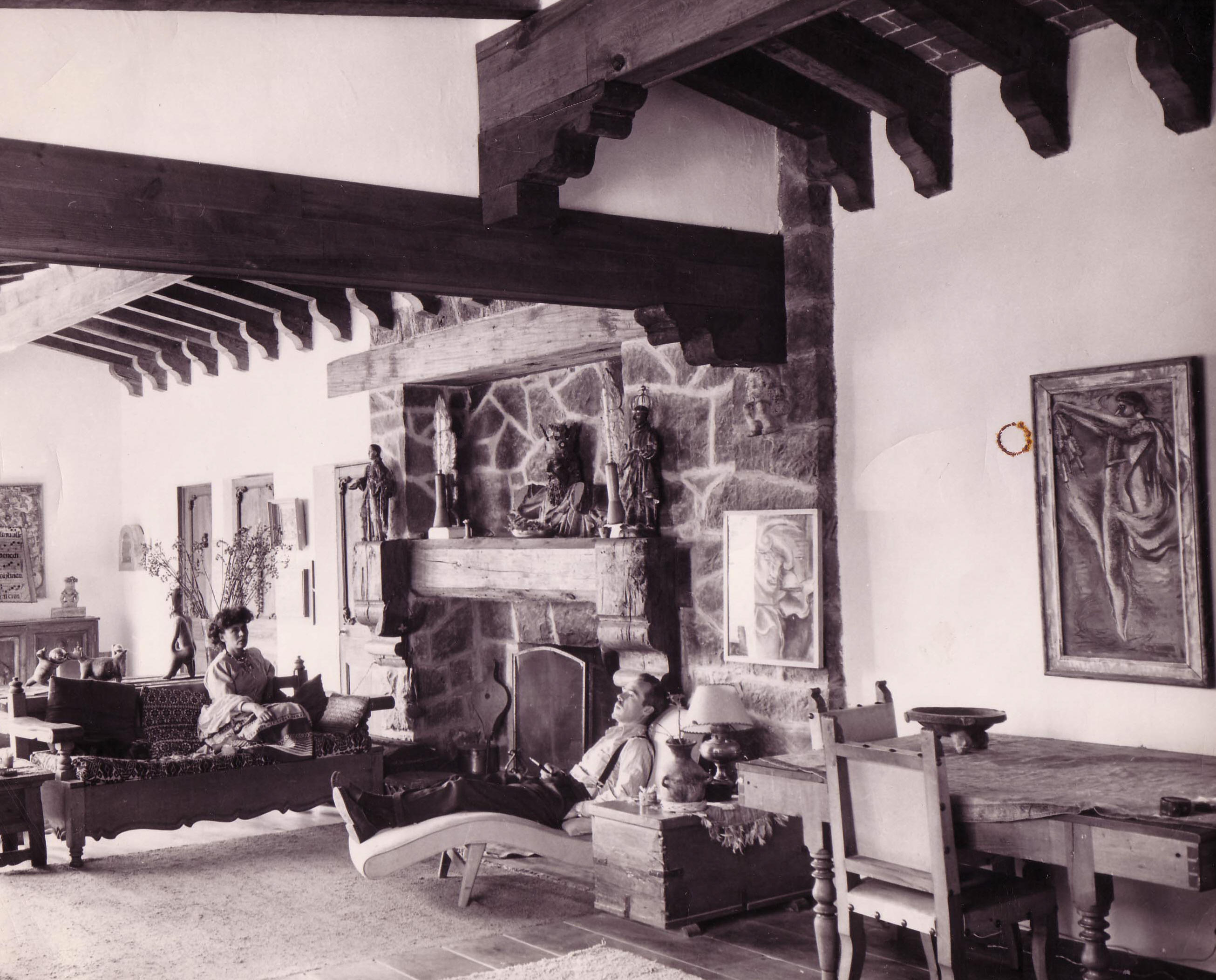 |
| Annette and Conlon, Aguilas No. 48 |
Conlon built his sound proof studio in the rear of this property.
Later, when he and my mother divorced, he built a small house next to his
studio and this property became Guiles #46). My mother was a very
gregarious person and always had many friends visiting. As a five or six
year old boy, I never thought of Conlon as anything more than one of her
many friends. (Years later my brother and I learned that my parents'
marriage was really over before my father joined the war effort. They had
decided not to let us know this in the event that my father might lose his
life. This way, we would simply think that he died in action and never
know that he and my mother had had a marriage that was in serious trouble.)
In any case Conlon was a frequent visitor.
Before my
father left for the war, my parents were involved in and formed part of a
group of friends that included artists, dancers, people in the music and
theater world and bullfighters.
I
think you know that my mother was an artist. Though my father was by
profession a businessman, he loved the arts and preferred to be among what
was then thought of as the "bohemian" crowd, than the business
group. He and my mother knew and socialized with Diego Rivera and Freda
Kilo, Jose Clemente Orozco and his wife Margarita, Juan O'Gorman and
Helen, Wolfgang Paalen, Rufino and Olga Tamayo and many other artists. My
mother was also friendly with David Alfaro Siqueiros and his wife
Angelica. My father's portrait was painted by Diego Rivera in 1943, before
he left for the service. I own this painting, and it hangs in my house
today. Orozco painted my mother's portrait. She also had portraits painted
by Jesus Guerrero Galvan, Federico Cantu and, later, by Pedro Friedeberg.
When the well-known American Black singer, Marian Anderson, came to Mexico
to perform in Bellas Artes, she was a guest in our house. My father taught
her the words and notes to a popular Mexican song, "Las Golondrinas,"
that is traditionally sung as a farewell song. She sang this, in Spanish,
at her last performance and received a tear-filled, standing ovation.
There is a photograph that was taken in front of
the main door of our house, of my brother and myself as small boys
standing with our parents, and Orozco, Marian Anderson and the bullfighter
Silverio Perez.
I give you
this information not because it particularly pertains to Conlon but
because it will give you some background as to the social scene he came
into when he met my mother.
Some time
after my father left to serve in the U.S. Navy, I recall my mother going
out in the evenings.
This
certainly must have been the period of time that Conlon was visiting. She
would tell my brother and I that she was going to a concert, which, she
explained, was going to hear music being played. We had a "nana"
that would take care of us. But one of my early memories, which had an
irksome connotation for me, was that she was going out "to a
concert." This meant that she would not be with us in the evenings.
This, however,
did not color my feelings about Conlon.
For me Conlon was always a pleasure. He was a nice and
interesting person to be around, and as far as I can remember he was never
hostile toward my brother or me. Quite the contrary, he was usually amused
by what we said or did, would laugh easily, and was, in general, totally
permissive. If my mother thought it was time for us to go to bed and we
wanted to stay up, he would say," let them stay up." I liked
going to a shooting gallery in San Angel at 20 centavos for 9 shots. My
mother would only pay for one round. Conlon would pay for as many rounds
as I wanted. I loved sweets and ice cream, which my mother was against and
never seemed to have in the house. Conlon would allow this. On one
occasion, driving alone with him in his car, he actually stopped the car
at an ice cream store to buy me a Popsicle, called "kikoleta," a
favorite item at that time. I
was flabbergasted that he had done this for me!
My father
survived WW II. During
part of his time in the service my brother and I traveled with my mother
to see him in Navy boot camp in Gulfport, Mississippi, and in Newport,
Rhode Island. Later we travelled to Reno, Nevada, where we stayed in two
separate "dude ranches," (essentially divorce residences) for
six weeks. Charles and I had no idea why we were in Nevada, (the only
state in the U.S. that, at that time, allowed for uncontested divorces).
We were told about the divorce after the war, after it had become a fait
accompli. This news was given to us in our parents' bedroom in the Aguilas
#50 house right after my mother had nursed my father back from an almost
fatal bout of true tomane poisoning. […]
Needless to say their divorce was shocking for me. Though my brother was older and may
have sensed something, I had no idea whatsoever that my parents' marriage
was in trouble, and I was upset and confused by the break up.
After this my
father remarried, in 1945, to Helen Hall. He resumed his businesses in
Mexico and rented a house in San Angel, at General Aureliano Rivera #4. Here he lived with his new bride, a
young woman my brother and I liked immediately and have cared about for
years to come. My mother married Conlon about a year later. When my father
and Helen moved out of the Aureliano Rivera house to live in a new house
that my father had built on Calz. Taxqueña, my mother rented Aguilas #50,
and she and Conlon moved into this very same Aureliano Rivera residence.
This was the house that had walls that were about one meter thick. And
this is where I got to know Conlon much better as a person and as a
stepfather.
At Aureliano
Rivera Conlon was always working on some project, usually something to do
with music, or recordings. One
of the first projects I distinctly remember was a mechanism he had
acquired which looked like a turntable with an arm to play records. But in
this case the arm, with a diamond stylus, would not play a record but
would cut a record, that is, cut the grooves into a plastic record like
disc. As it would cut the recorded grooves a thin filament of material
would come peeling off the disc, like thread, and wind itself away into
twisted balls. We would find these black filaments all around the living
room. We could speak
into a microphone and have this mechanism record our voices.
 |
|
Nancarrow
experimenting with a tape recorder |
Another devise
that Conlon used, at a somewhat later date, was a tape recorder with large
reels and thin, light brown recording tape. As I remember one of his early experiments was to record
percussive sounds of a variety of drums or other instruments on to this
tape. He then would cut the tape into small sections, some as small as a
centimeter or so. Subsequently, he would tape these sections together with
some sort of scotch tape in a deliberate pattern that he hoped would form
his composition. He would then play the composite tape back to hear what
it would sound like. Eventually,
he had to abandon this procedure as it was not only terribly time
consuming but did not give him the precision he desired.
One of
Conlon's closest friends at the time was an American man named Bob Allen. Allen's wife Angeles was Mexican, and
my mother and Conlon and Bob and Angeles were frequently together. Bob was
a technician of some sort and was helping Conlon to develop an instrument/mechanism
that could use piano like hammers to strike any of a series of surfaces.
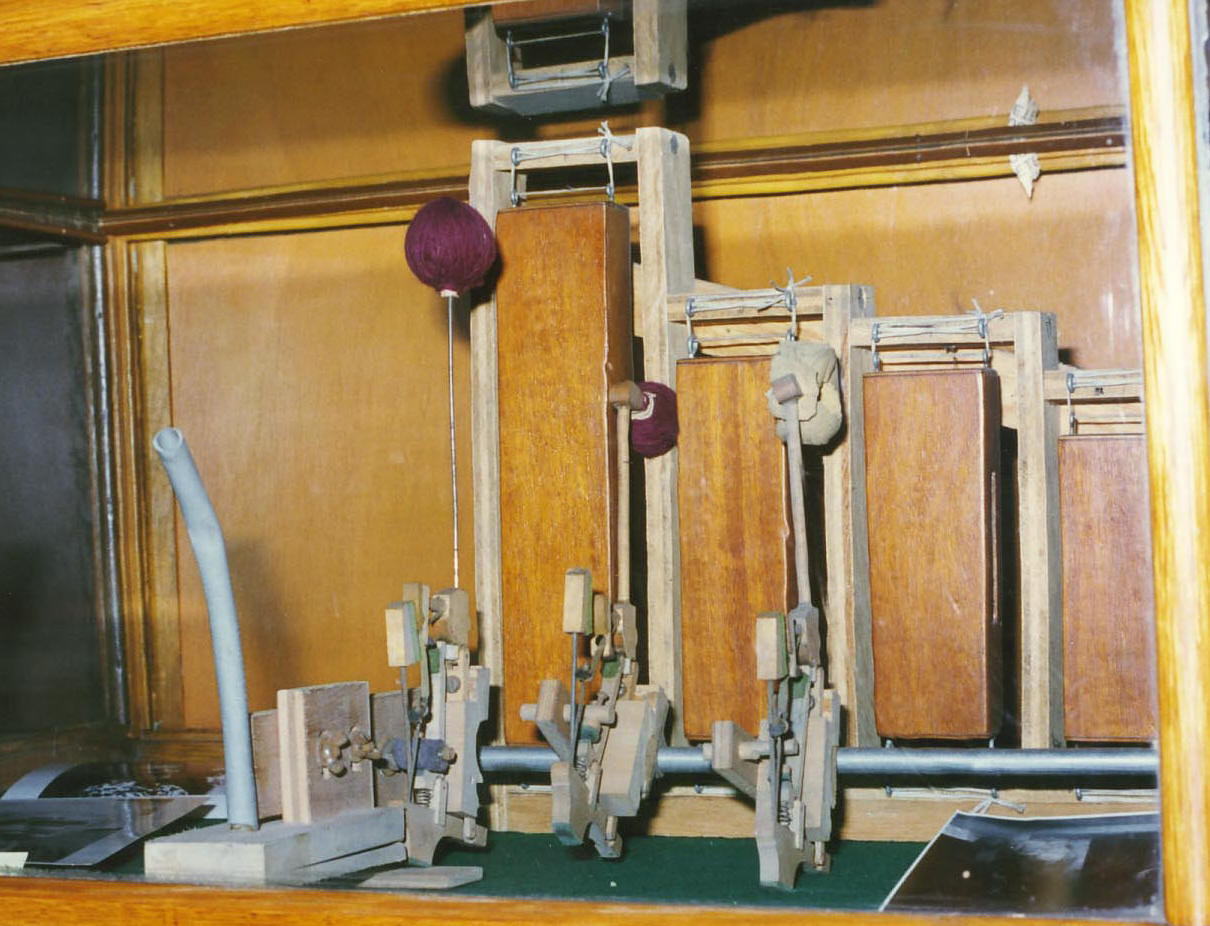
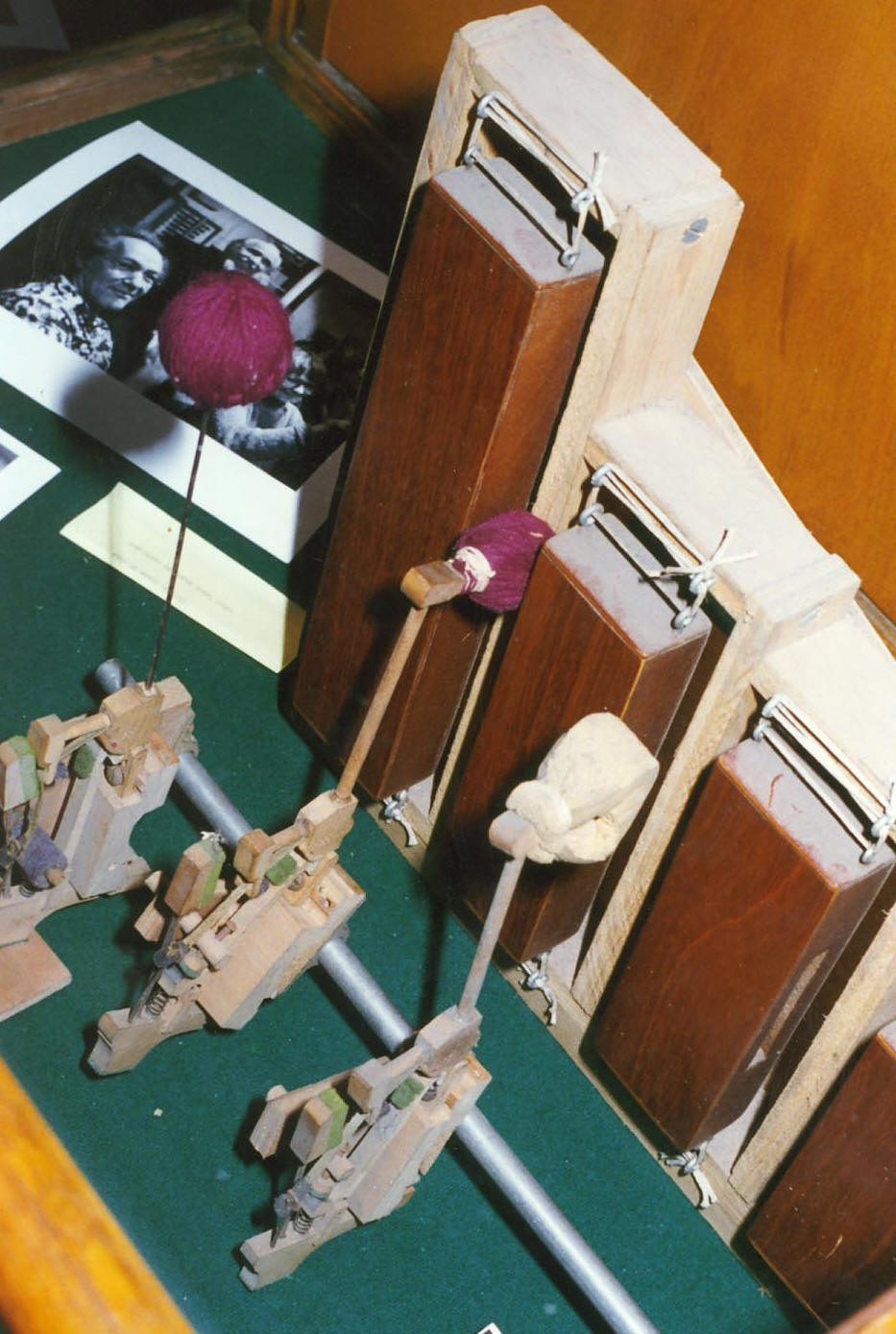 |
|
Piano hammers operating percussion devices. Fotos:
Jürgen Hocker |
I
believe they would rely on an air pressure or vacuum device to activate
the hammers, possibly via a perforated roll like the player piano. At
that time Conlon purchased quite a number of drums, some rather well made
and handsome ones which I think were Chinese, but also others that might
have been Indian as well as Cuban and Mexican. These were later put into a
large vertical wooden rack that went up about three to four meters and was
about six meters wide. Included in this rack were a number of drums that
Conlon himself made.
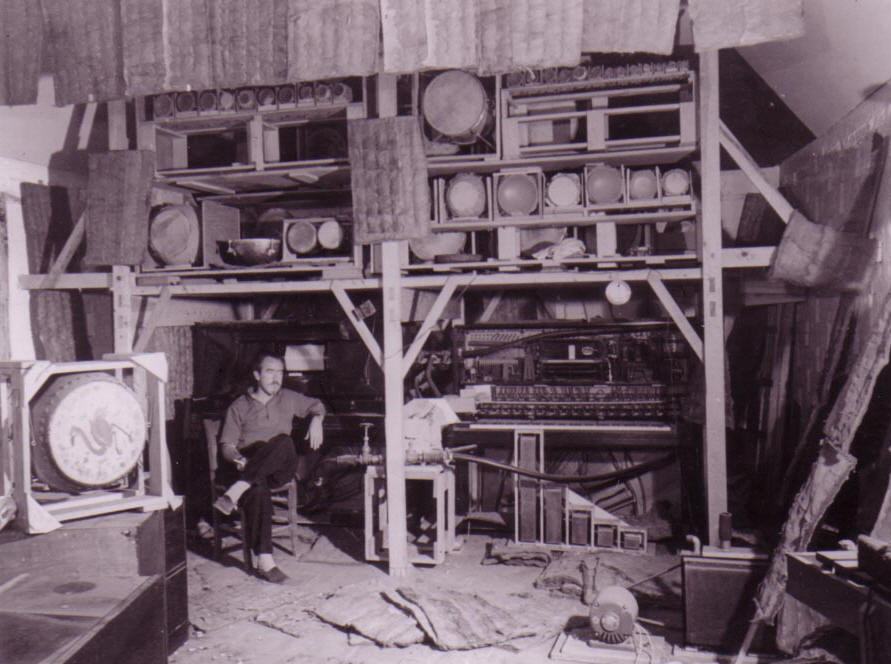
Nancarrow and his percussion
orchestrion, commanded by an Ampico player piano (approx. 1950).

Nancarrows Percussion "Instruments" |
These were the
most interesting to me since I had the experience of watching him make
them. Conlon bought Mexican clay "ollas,"
or pots, of varying sizes; the largest were about 70 cm high and the
smallest about 30cm high. He would take a hacksaw and saw off the bottoms
of these pots about 5cm parallel to the bottom. He would then take kidskin
that he had soaked in water overnight and stretch it over the hole that he
had cut away and tie the skin to a thong he had strapped around the neck
of the pot. This was done in a crisscross pattern so as to get the maximum
tautness on the stretched skin. He would then place this pot upside down,
i.e., skin side up, in the sun until the kidskin dried and shrank very
tightly over the opening he had cut away. Viola! a beautiful drum! And one
that had an unusual and melodic sound.
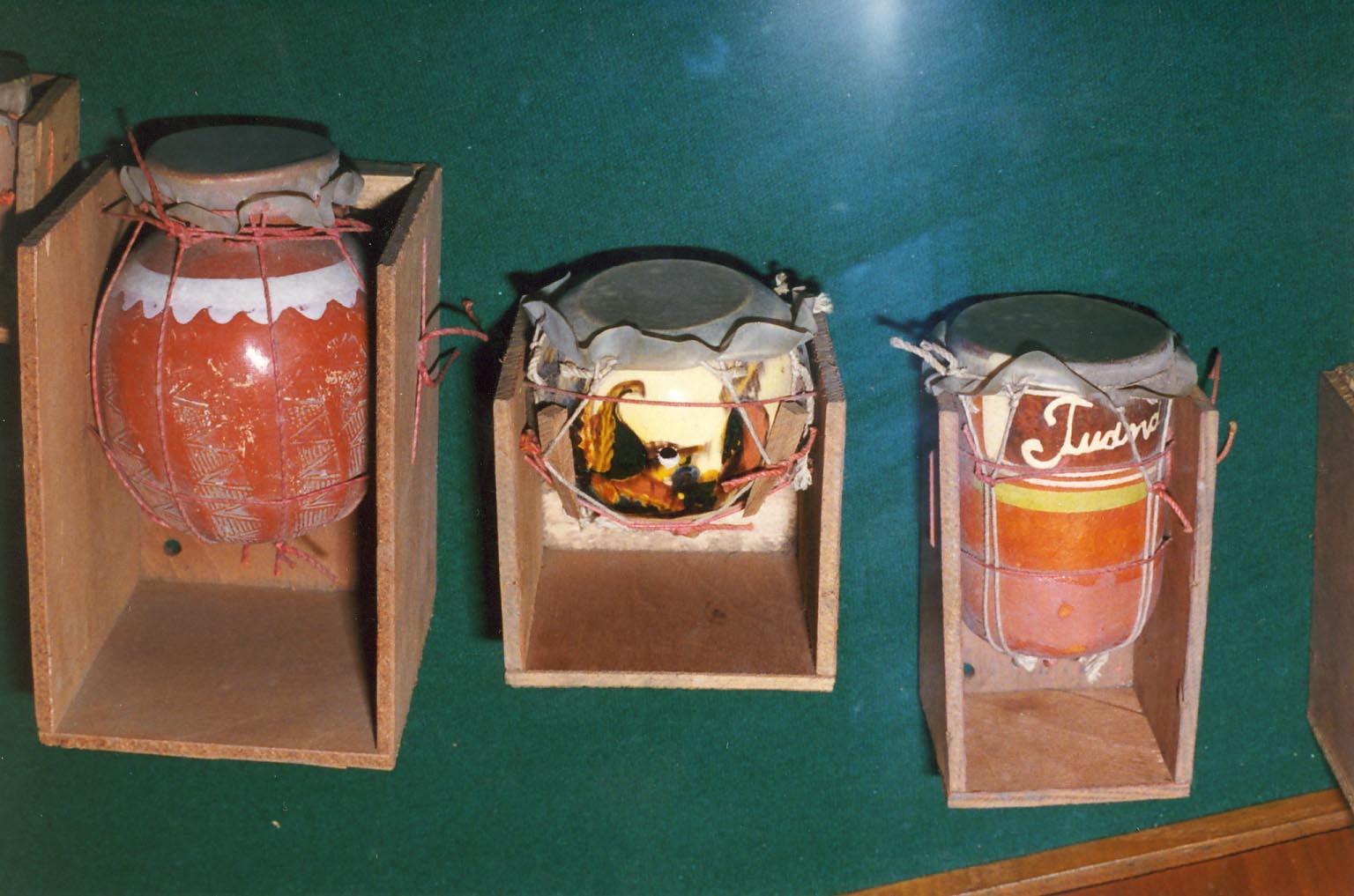 |
|
Percussion instruments Nancarrow built
from Mexican clay "ollas"
or pots. Foto:
J. Hocker
|
These were the
kind of activities that especially delighted me since they were manual and
creative and I, myself, always took delight in working with my hands. When, a couple of years later we were
to move into the Aguilas #48 house, where Conlon had built his studio, he
had a carpenters workbench and all sorts of hand tools there. Tools
fascinated me and Conlon would let me use them, or be with him while he
was working, with no objection whatsoever. He was a perfectly agreeable
and accommodating adult and didn't mind my childhood presence.
As you know
Conlon's drum rack never came to be used as he had envisioned. I think he and Bob eventually gave up
trying to construct the operative mechanism and Conlon finally worked out
his punching machine for his Ampico player pianos. I know he would have
wanted to have at his disposal a greater variety of sounds, but since that
proved complicated, he settled on the piano keyboard as sufficiently
diverse for his purposes. Years later when musicians and composers began
using the synthesizer Conlon remarked to me that, had he been born into
this current generation, he would certainly have composed music for the
synthesizer. Didn't he think he could start now I asked. "No,"
he replied, "it's too late for me now, I already have my niche."
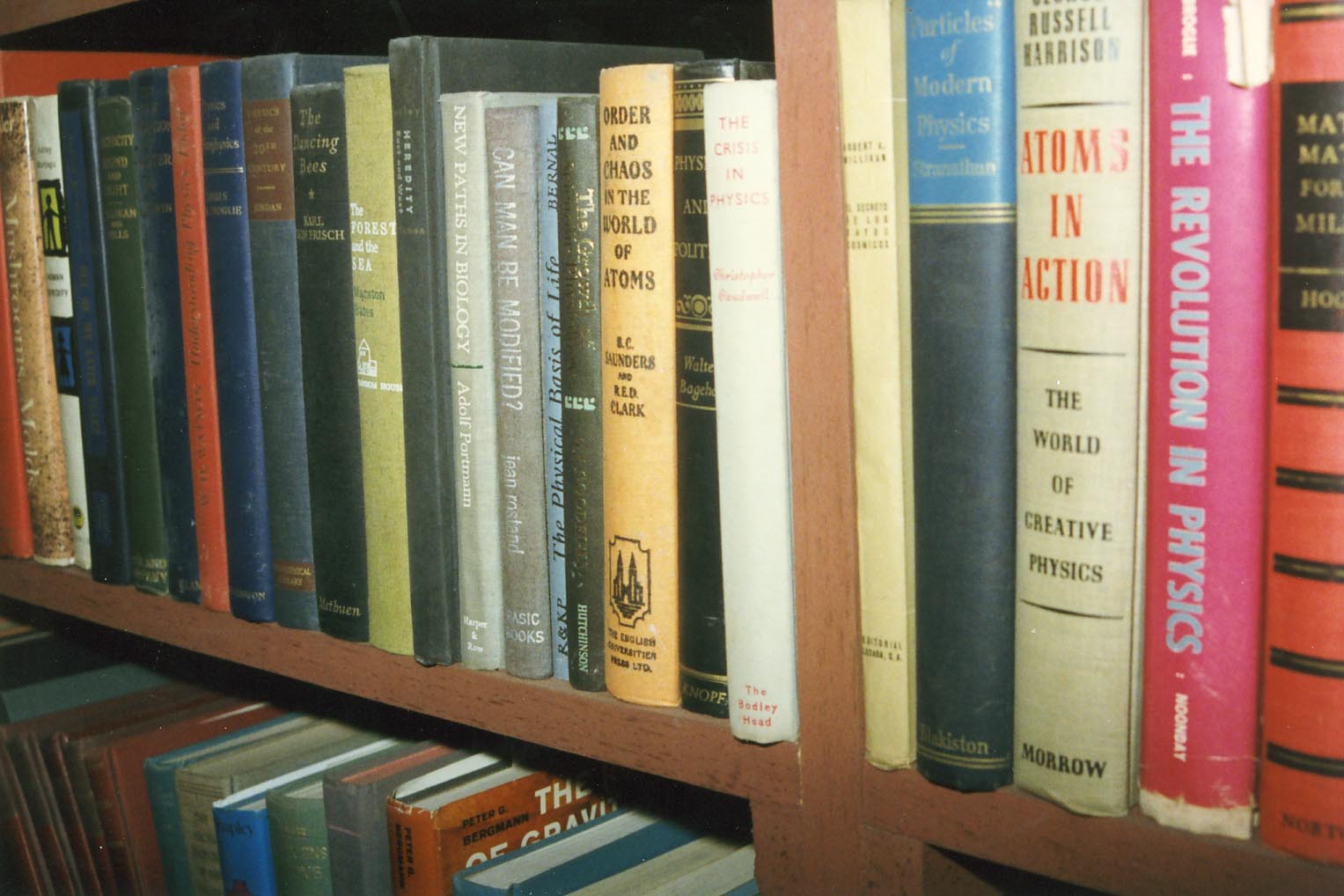
|
Nancarrow owned a huge library. Foto:
J. Hocker
|
Conlon was a
tremendous reader and read books on all the subjects that fascinated him. In addition to books about music he
was also interested in astronomy, language, physics, cooking, mathematical
theory and political philosophy. He read at least three different
newspapers every day. He smoked heavily; three to five packs a day, and
drank small cups of thick, black Turkish coffee, which he would make
himself. He had a whole system of whipping up the fine grounds in a little
copper, crucible like pot to produce a frothy, foamy expresso result. Conlon might have smoked "Gauloises"
occasionally, when he could get them, but his favorite cigarettes for
years were "Soberbios." These were either Mexican or Cuban and
were made with a very strong, dark tobacco, unfiltered, of course.
Conlon never
worked at a regular job. When
I became old enough to ask about this my mother explained to me that he
had received an inheritance from a life insurance policy of his father's
that allowed him to have some sort of steady income.
Conlon gave me
my first introduction to things like atoms and explained what they were. He also told me about the solar
system, stars, galaxies and the universe. These were subjects that I found
very much to my interest and I continue to be interested in cosmology to
this day. He also played chess quite well and we often paired off. Though
he was usually the winner, he would compliment me on my "good game."
One day my mother bought us a children's book on Mozart. This book showed
how Mozart was playing advanced musical compositions on the piano when he
was only four years old. I asked Conlon if Mozart was his favorite
composer. Mozart was one of his favorites, he said, but his very favorite
was Bach. Did Bach ever write any bad music, I inquired. Conlon replied
that as far as he was concerned Bach never composed a single piece of
inferior music. His favorite contemporary composer was Stravinsky. At a
young age I became familiarized with these names.
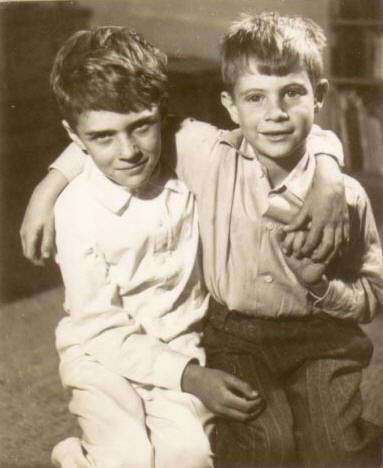
|
Annettes sons Charles (left) and Luis |
I mentioned
that he was permissive. I
started smoking cigarettes, secretly of course, when I was quite young. Many
of our lunches in the San Angel house we had outdoors in the garden at our
table for four. Invariably,
after lunch Conlon would pull out his pack of cigarettes for a smoke. He
would tap the pack and first offer one to my mother. One day at lunch he
did this. I had my pack hidden in my pocket. He reached across the table
to my mother with his opened pack and said, "dear?" "Oh,
thank you," she said, and took a cigarette. Conlon lit their
cigarettes. I then took my pack out and tapped a few out and reached
across to my brother Charles and said, "dear?" "Oh, thank
you," Charles responded and took one, which I then lit. Conlon
couldn't stop laughing! My mother, also, but she protested. Conlon said to
her, "Don't be silly, let them smoke, what difference does it make!"
I was seven, Charles was eight.
For the
greater part of their marriage together Conlon and my mother lived in
Aguilas #48, where Conlon had his studio at the rear of the property. My mother loved entertaining but, for Conlon, groups of more
than six or seven people were uncomfortable for him. As long as the groups
were small he would be cordial and affable and talkative. But with larger
groups he could get painfully shy and timid and self-conscious. Whenever
my mother had a large party he would invariably run off to his studio and
lock himself away until the people had left. Some of my mother's friends
thought this behavior was antisocial and in poor taste. But most of the
good friends simply explained that this was the way Conlon was.
Conlon
collected all kinds of recordings from all over the world. During those years these were of the
breakable, 78rpm variety. He had established a contact in Africa, I'm sure,
but perhaps also in other countries, India or China or the Middle East,
who would mail him records. We used to listen to these in our living room.
So at the age of 10 or so, I was exposed to ethnic music from strange and
distant places and I became accustomed to hearing these sounds; a lot of
chanting kind of music, a lot of drumming.
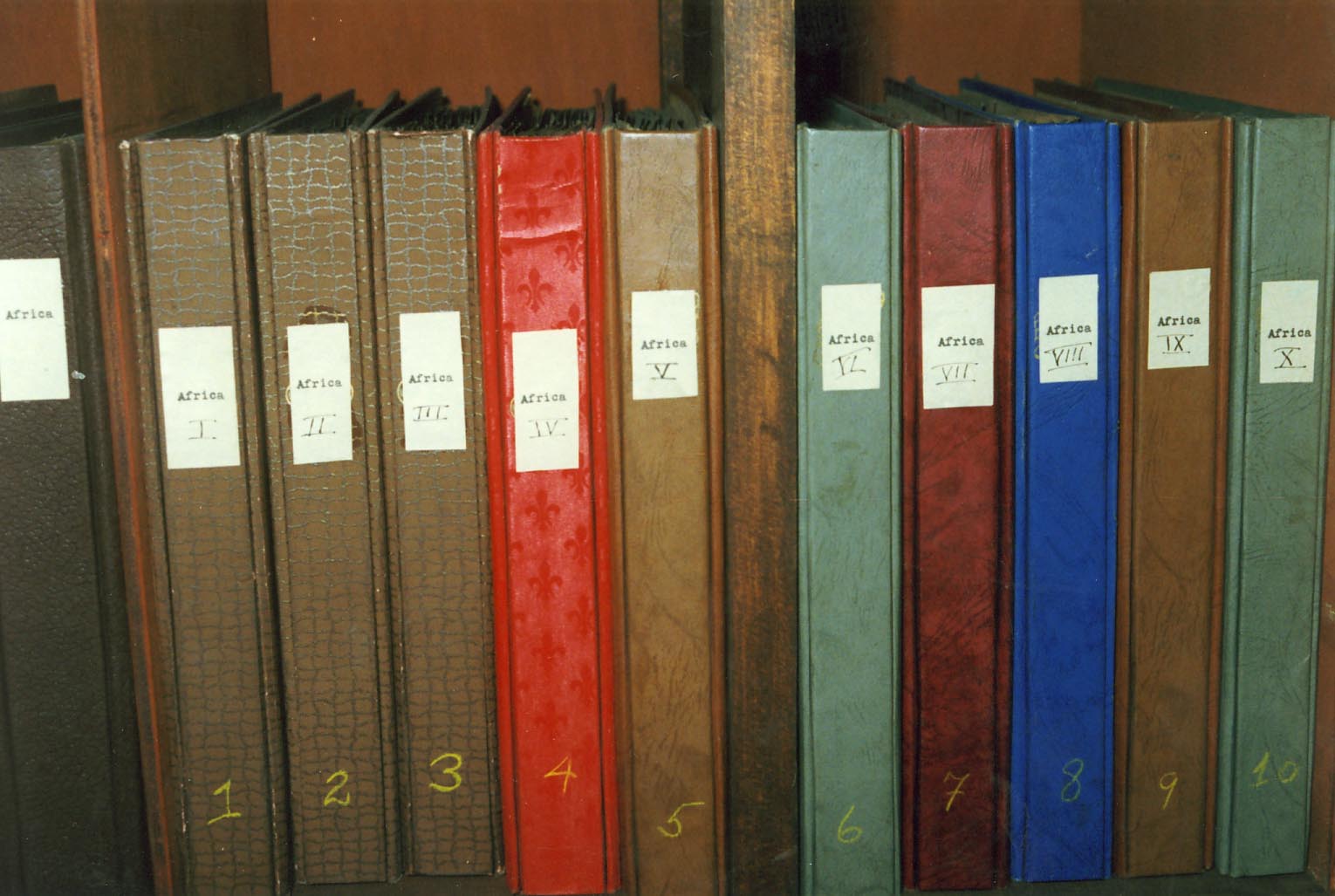
|
Nancarrow collected ethnic music Foto:
J. Hocker |
At the same time we would often
take invited guests to his studio to listen to his own recent compositions.
With a rather deadpan expression he would play us his latest rolls and
then ask us if we liked this one or that one better. You can imagine how
avant-garde this music sounded in the 40's and 50's! But I grew to like
his music. There was one piece that sounded like bullfight music, like a
piece commonly played during the "fiesta brava" called "La
Virgen de la Macarena." Other pieces were also favorites of mine,
especially those that had a boogey-woogey beat. Years later, when I was in
my late 20's, I would frequently take a girlfriend to his studio to meet
him. We would talk and then have him play his music for us and serve us a
little coffee and odd cookies. His little house and kitchen was an
attractive and artistic den, the music was outlandish; it all made for an
eccentric, wonderful evening.
But perhaps
the best part of his record collection was the jazz. Especially Louis Armstrong! This seemed to be his favorite
interpreter and he would frequently play us many of Louie's recordings. He
loved them and his enthusiasm for Armstrong was contagious so we learned
to love them too. Armstrong would not only play his trumpet and sing with
that unique, raspy voice of his, but he would also talk and joke which
made Conlon laugh with uproarious delight! I remember one particular
record that was in the collection called, "Laughing Louie." This
was an especially amusing piece because it must have been recorded when
Armstrong was high on liquor, and he was laughing and joking and singing
all at once in the most hilarious way. We would ask Conlon to play this
piece again and again and we would laugh throughout the hearing. I wonder
where these 78's are now? I hope Yoko or Mako have retained this
collection.
Conlon had
somewhat of a macabre sense of humor. He, therefore, very much enjoyed the
cartoonist Charles Adams. After
Adams became well known, his cartoons were published in book form. My
mother, or my sister, I don't quite remember whom, gave Conlon one of
these books as a present. As he opened it and read it we would sit beside
him on the couch, because, with his reading of each cartoon, he would
laugh so heartily, and with such amazed surprise, that it became our
pleasure to enjoy his! Conlon always enjoyed a good joke, or dirty story,
and would laugh easily, and this was an endearing characteristic he had.
There was one exception to this. He did not tolerate, nor would he laugh
at jokes that had ethnic slurs. Almost without exception these were met by
stone-faced disapproval and no laughter at all.
Conlon loved
food and would try anything, virtually anything that was edible. He also liked to prepare food, as did
my mother. They were both good cooks and would experiment with new tastes.
As you know Mexicans eat every part of the animal including organs, skin,
viscera, feet, ear, snout, etc. We frequently ate heart, liver, tongue or
brains at our meals as well as more conventional fare. Concerning this
subject there are two things that stand out in my young memory. One is
that Conlon liked smelly cheeses. He would buy some sort of stinky cheese,
then wrap it in what looked like old, dirty, damp rags and hide this
bundle in a dark corner of the closet pantry in our kitchen for several
days. When he would pull this bundle out and unwrap it, the cheese seemed
to be covered with mold, which he would then scrape away to find a gooey,
runny substance underneath. This he would spread on black bread or
crackers and then eat with great delight. The smell used to make me ill; I
could barely control my desire to wretch. Conlon would smile and eat away.
The other memory is of eating "percebes." These are barnacles of
some kind that have a shell-like head and a snake-like body covered with a
cloth-like skin. They are about 6 inches long and are eaten cold and raw.
Conlon would
break the head off and peel the skin back and then eat the reddish brown,
worm-like body that remained. The
more repulsive this looked to me the more he would smack his lips and
exclaim how good it tasted. He was not fazed by the look or bizarreness of
food. For him food was just food and had no psychological connotation. (You
probably have knowledge of the fact that during his time in the Spanish
Civil war, on the battlefield, one of his friends woke up early one
morning only to see Conlon crawling around on his hands and knees eating
grubs and snails that he dug out of the dirt. This is a well-repeated
story.) But Conlon also enjoyed very conventional foods and I remember how
much he loved a rich, chocolate ice cream Sunday, or fresh fruit. He would
pick out and save the best mangos or papayas or pears and eat these with
equal pleasure. He never grew fat and did not watch his diet from that
point of view. One of his great delights was to pick ripe figs from our
garden fig tree, slice them up into a bowl, douse them with heavy sweet
cream, spread sugar on them and have them for dessert.
My brother and
I frequently traveled with my mother and Conlon to Acapulco. But later in their marriage when my
sister Cherry, or other friends of my mother's would join us during the
summer, I think Conlon chose to stay in the city. Conlon liked the beach,
liked to swim as I remember, or read under a thatch umbrella. We usually
stayed at Hotel Mirador, which had cottages high along beautiful seaside
cliffs; this was above the "quebrada" where the divers would
perform their famous swan dives from about 42 meters up. The cottages usually had a hammock for after lunch relaxation and, as I
recall, Conlon would shower quickly to insure that he got to the hammock
before my brother and I did. These were little friendly competitions.
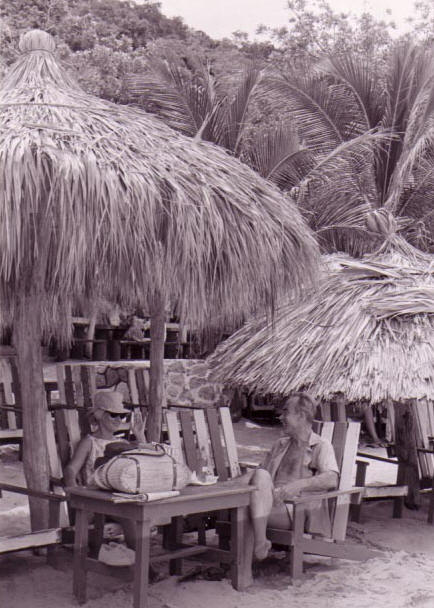
In Acapulco
I would not be
giving you a complete picture of Conlon if I didn't mention his commitment,
especially during the 40's and 50's, to communism. Conlon's politics were always leftist but during the early
years he actually declared himself a communist. My brother and I would
have discussions with him about this and, as small boys we were unable to
articulate a counter position. During college my brother majored in history and
became particularly interested in political theory, and also became
convinced that Soviet communism was as extreme and deplorable as fascism,
though on the opposite pole. So after graduating from the University of
Wisconsin Charles decided it was time to have another discussion with
Conlon about this subject. He had me join him and we both went
over to Conlon's house to talk communism. It was one of those occasions
where the children face their parent, in this case ex stepparent, with a
subject that was always an issue, but where the parent had always been
dominant. My
brother argued persuasively -- by this time he had acquired much more
knowledge on the subject. Conlon was almost unable to defend his position.
It was as if Conlon's political house
of cards just crumbled away. I realized as time went by that Conlon was
not really a political activist of any sort. Other than his experiences as
a young man with the Lincoln Brigade in Spain, which you probably have
much more information about than I have, Conlon was really a non-violent
person who hated racial intolerance. His commitment to communism was a
romantic desire to find a system that would provide social justice among
men, but which he later realized was not the case. In his own words he
says that he became "disillusioned" with communism. I suspect
that my brother Charles still has issues about this subject vis-à-vis
Conlon. You may wish to get his version on this.
After my
mother and Conlon divorced and until he married Yoko, Conlon continued to
live in Aguilas #46. At that
time his compound was only a small bedroom and kitchen attached to his
library and soundproof studio. Neither I nor my mother, nor any of his
friends that stayed in Mexico lost contact with him. We remained on good
terms and visited him with some regularity. He always received us well. He
lived pretty much as a hermit, writing his music, drinking quite a lot,
smoking, cooking his own meals. During
these years I don't know what his love life was like. […] In general, I
considered Conlon my friend, and as mentioned, would visit him either
alone or with a girlfriend, and these visits were always pleasurable. I should mention that since 1964, we
were next-door neighbors.
After he
married Yoko and Mako David was born Conlon's life changed. I can only think that this was a very
positive thing for him. I'm certain he adored Yoko and was enthralled that
he had a son. Mako was about three years older than my oldest daughter,
Phoebe, and four years older than my son, Luis Jose. They would often play
together in our garden.
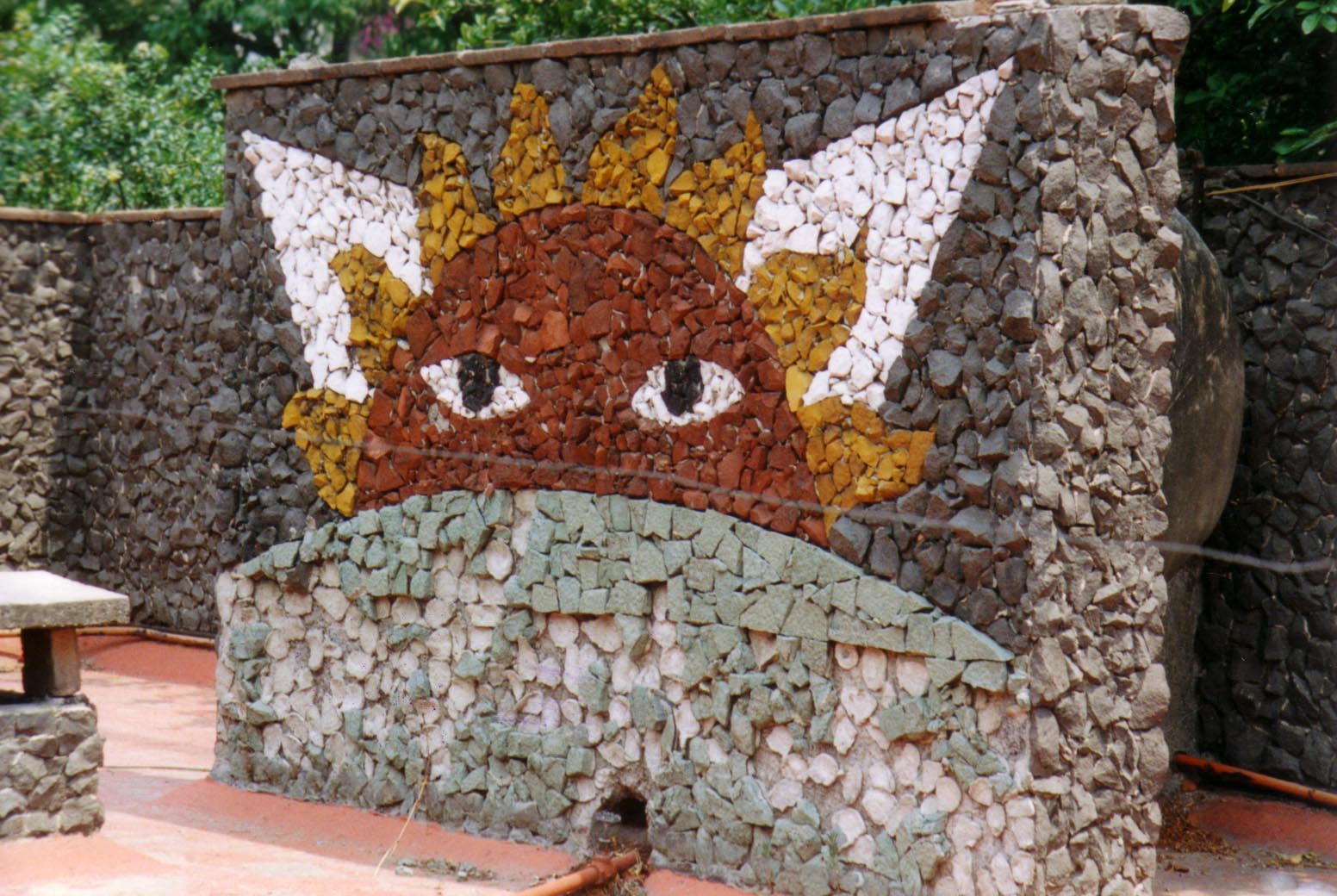
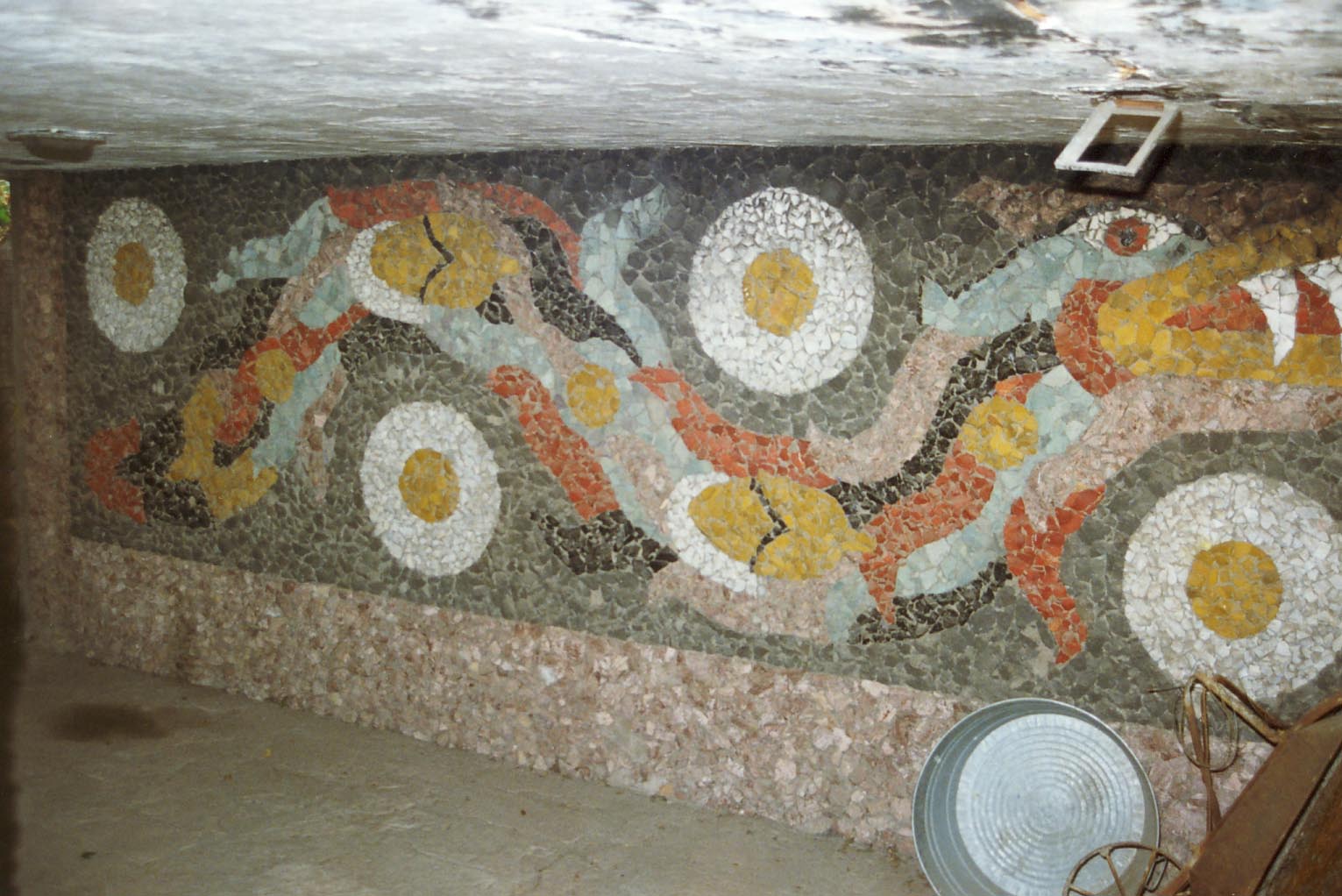
Stone mosaics by Juan O'Gorman on Nancarrows new house. Fotos:
J. Hocker
With his
marriage Conlon expanded his house. The person involved with this new building project was his long-time close
friend, artist and architect,
Juan O'Gorman. O'Gorman built Conlon and
Yoko a nice two story house and covered many of the exterior walls with
his famous colored stone mosaic
Conlon and O'Gorman shared a healthy
leftist political viewpoint. They also shared ideas about suicide. I
believe it was O'Gorman who introduced Conlon to a book called "Exit,"
that had been published in England, I think. It was a kind of "how-to"
book for taking ones own life. Toward the end of his life O'Gorman talked
frequently to Conlon about this subject to the point where Conlon became
concerned, a concern he shared with me. You may know that some years later O'Gorman did
take his own life in his house in San Angel. To insure that this act would not fail
O'Gorman put a ladder against a tree, tied a sturdy electrical cord around
the tree and then around his neck, then drank cyanide and shot himself
through the temple.
After my third
child, Dustin, was born, my wife and I separated. I moved into a small studio around the corner on Leones
street. About a year later I met Karen and invited her to come to Mexico.
Just at that time, and completely by coincidence, I received a phone call
from, of all people, Helen O'Gorman. She was wondering if I might be
interested in buying Juan's pre-Columbian collection. When I visited her
she also explained her house was for sale, the same house where Juan had
ended his life. This
house was one of Juan's early functionalist structures one block away from,
and in the same style as, Diego's [Rivera] and Frieda's [Kahlo] studio,
which he had also built. The
O' Gorman house included his painting studio. I should tell you that in
addition to being a businessman, I am an artist; indeed this is my real
love, my preferred vocation. I ended up buying this house. Helen
included the collection with the purchase.
Karen and I
began living together here in about 1983. In 1985 she and I were married; our daughter Caitlin was
born in 1986, and our son Tommy was born in 1989. In 1991 we sold this
house and moved back to Aguilas 48, in an exchange where my ex-wife moved
into another residence nearby.
One final
anecdote. Little by little Conlon's music was
becoming more widely known. That is, it was always known in some limited
circles, especially after Columbia, or Decca, I don't remember which
[Columbia], produced his first recordings. But in the late 80's Conlon's music was getting more
notoriety. He had several friends in San Francisco who were backing him. One
was Charles Amirkhanian and another was a woman, Eva Soltes. Conlon confided to me that he was
beginning to get too much mail and that it was hard for him to handle all
this correspondence as well as a demand for his presence at concerts. After several
conversations like this I asked him if he trusted Eva Soltes. To this he replied that he trusted her
fully. So I suggested he consider making her his agent. This he did and
then she began answering his mail and scheduling appearances. Later he
said to me with some pride, "you know I have an agent." I
reminded him that I was the person who had suggested this to him. He
seemed to have forgotten this but then nodded his recollection. Though I
know that he and Eva eventually broke company, I believe that she and
Charles and perhaps others were instrumental in helping him get the
McArthur Genius Fellowship. This was clearly the professional highlight of
his life. Karen and I felt it couldn' t have happened to a nicer person.
Conlon, for years and years had been composing his music, totally
dedicated to this creative enterprise, with no widespread recognition, and
then finally in his winter years and when finances were almost depleted,
he became front-page news in the music world and received a three hundred
thousand dollar prize! What a nice conclusion.
I hope that
what I have written is of some interest to you. I'm sorry that Yoko did not give you my address sooner but
perhaps some of this information could still be pertinent for your
purposes.
My best wishes to you and your family as well for Christmas,
and the best of success for you and your book in the New Year.
Muchos saludos, Luis Stephens
To top
|